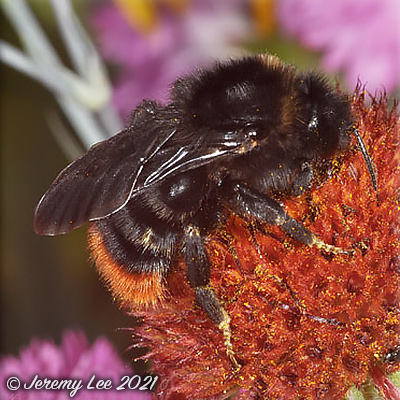
 |
|
Scientific Classifications explained » Amphibians » Ants » Aphids » Bees » Beetles » Birds » Bugs » Butterflies » Caterpillars » Damselflies » Dragonflies » Earwigs » Flies » Frog/Leafhoppers » Fungi » Galls » Grasshoppers » Harvestmen » Hoverflies » Lacewings » Ladybirds » Leaf Mines » Lichens » Mammals » Millipedes » Mosses » Moths » Sawflies » Slugs » Snails » Spiders » Trees » Wasps » Wild Flowers » Woodlice |
UK Nature > Bees > Bombus rupestris

Scientific Name: Bombus rupestris Common Name: Red-tailed Cuckoo Bumblebee Bombus rupestris is one of the Cuckoo Bumblebees, so called because of their habit of finding a nest of their host species and infiltrating it. The young Bombus rupestris queens over-winter and emerge later than their hosts the following Spring, to take over a nest of Bombus lapidarius. It is one of our largest bumble bees; the female is much larger than the male, having a length of 20 to 25 mm, while the drone usually is not more than 16 mm. The bumblebee is mostly black, with the last abdominal segments coloured orange-red. Due to its parasitic lifestyle no workers exist. Bombus rupestris is usually found in flower-rich habitats such as meadows and along hedgerows but also in urban gardens, where this photograph was taken. It was once considered to be somewhat of a rarity, but numbers seems to be on the rise in recent years. |
|

https://www.uknature.co.uk is a website dedicated to showing the immense diversity of UK nature and wildlife. Our vast range of habitats, from lowland arable to snow covered mountains, from storm-ravaged coastlines to peaceful inland freshwater lakes and rivers, from dry, sandy heaths to deciduous and coniferous forests, all these habitats contribute to the abundance of UK nature. We have wild birds in huge numbers either residing or visiting our shores (597 recorded species as at July 2013) and we must also not forget the humble back garden with its grass lawns, flower beds filled with nectar rich flowers, shrubs and trees, all designed to attract huge numbers of insects such as bees, moths, butterflies and hoverflies; and finally the small ponds which provide safe havens for frogs, toads, newts and even slow worms and grass snakes. www.uknature.co.uk is the showcase for my personal passion, photographing uknature in all its glory. I sincerely hope you all enjoy the fruits of my labours. This site and all images contained therein is © Jeremy Lee 2004 - 2021. All Rights Reserved. Site design by Jeremy Lee. Site development & IT Support by Stuart Lee. |